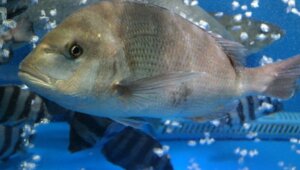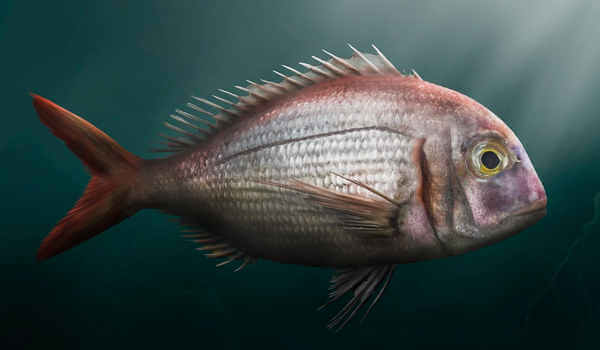5 Curiosities of Sea Bream


Written and verified by the psychologist Sara González Juárez
It’s quite possible that you’ve never been particularly curious about the sea bream – after all, there are so many other wonders we could investigate in our oceans. The height of our knowledge about this fish is possibly what it looks like on a plate!
However, it never hurts to get to know what it’s like in its true environment – as a free living being. There’s much more to get to know than what it looks like on a plate. So, with this in mind, we’re going to bring you some curious facts about it so that you don’t get lost in the “sea” (if you’ll pardon the pun) of cooking pages that appear when you search for its name online.
Brief summary of its biology
The sea bream has the scientific name of Pagellus bogaraveo. It’s a perciform fish of the Sparidae family and belongs to the genus Pagellus, which also includes other fish such as the red pandora (Pagellus bellottii) or the Pagellus acarne.
It’s a widespread species in the western Mediterranean, as well as the eastern part of the Atlantic, from Norway to Mauritania. While other sparids are distributed in seas all over the world, this species is the only one that’s widespread in the seas of northern Europe.
It’s an omnivorous fish, and the sea bream hunts mainly crustaceans and other invertebrates, but also fish smaller than itself (it can reach up to 60 centimeters – about 24 inches – in length and weigh more than 6 kilograms – 13 pounds). It also pecks at algae and other types of plant matter found in its environment.
Curiosities of the sea bream
Now that you’re a little more familiar with this fish’s biological makeup, let’s take a look at some extra curiosities about it. There’s still a lot to discover about the oceans, given our terrestrial nature and just how vast the oceans are. That’s why we’d like to encourage you to get to know these curiosities about the sea bream.
1. A small portion of its population is hermaphrodite
It’s estimated that 10% of the sea bream population is protandric hermaphrodite. This means that, in these fish, the male reproductive system develops before the female, and at a certain point in the life of the fish, it will change sex and become a female.
The sea bream reaches sexual maturity at the age of 2 years, when it reaches 15-20 centimeters (6 to 8 inches).
2. Its name is an insult in Spanish
Human language, often innocently, gives animals a bad name, literally. In Spanish, they use the insult “besugo” (sea bream) when they’re trying to say that someone is a bit stupid or dim.
When we do this, that word association gives us the totally wrong impression that this fish may be particularly stupid or dumb, just because of the idiom about them. An equivalent in English could be when we call someone a donkey, meaning that they’re stupid. We may get the impression from this that donkeys are stupid, when, in reality, they’re actually quite intelligent.
In the long run, this lack of empathy can even end up diminishing efforts for the conservation of the species.
3. Its location depends on age
Another of the curiosities about the sea bream is that, in general, it lives quite deep in the oceans – at about 700-800 meters (2300 to 2600 feet) in the Atlantic and 400 (1300 feet) in the Mediterranean. However, when they’re young they inhabit more benthic areas, forming small shoals that grow in number and go deeper as they get older.
4. It was already eaten as food in the Neolithic period
Humans have fished this animal for consumption since ancient times. In excavations carried out in Scotland, remains have been found to suggest that it was a fairly common food among humans of that period. Of course, fishing exploitation had a much more minimalist character than what we know today.
5. It’s under threat

Pagellus bogaraveo is currently listed as Near Threatened (NT) according to the IUCN Red List. Despite its wide distribution and the fact that populations aren’t fragmented, they’re declining year after year due to massive exploitation for human consumption.
It’s a species that’s sensitive to overexploitation, as its maturation period is relatively long compared to the frequency of the fishing it suffers. On the other hand, it’s also sensitive to climate change, as spawning and egg hatching depend, to a large extent, on water temperature.
This is why, despite the fact that its fishing is regulated in several countries and even restricted in the reproductive months, sea breams continue to reduce in number little by little. There are many factors affecting this species, so its conservation requires not only government action, but also a change of habits on a small scale to benefit it.
It’s quite possible that you’ve never been particularly curious about the sea bream – after all, there are so many other wonders we could investigate in our oceans. The height of our knowledge about this fish is possibly what it looks like on a plate!
However, it never hurts to get to know what it’s like in its true environment – as a free living being. There’s much more to get to know than what it looks like on a plate. So, with this in mind, we’re going to bring you some curious facts about it so that you don’t get lost in the “sea” (if you’ll pardon the pun) of cooking pages that appear when you search for its name online.
Brief summary of its biology
The sea bream has the scientific name of Pagellus bogaraveo. It’s a perciform fish of the Sparidae family and belongs to the genus Pagellus, which also includes other fish such as the red pandora (Pagellus bellottii) or the Pagellus acarne.
It’s a widespread species in the western Mediterranean, as well as the eastern part of the Atlantic, from Norway to Mauritania. While other sparids are distributed in seas all over the world, this species is the only one that’s widespread in the seas of northern Europe.
It’s an omnivorous fish, and the sea bream hunts mainly crustaceans and other invertebrates, but also fish smaller than itself (it can reach up to 60 centimeters – about 24 inches – in length and weigh more than 6 kilograms – 13 pounds). It also pecks at algae and other types of plant matter found in its environment.
Curiosities of the sea bream
Now that you’re a little more familiar with this fish’s biological makeup, let’s take a look at some extra curiosities about it. There’s still a lot to discover about the oceans, given our terrestrial nature and just how vast the oceans are. That’s why we’d like to encourage you to get to know these curiosities about the sea bream.
1. A small portion of its population is hermaphrodite
It’s estimated that 10% of the sea bream population is protandric hermaphrodite. This means that, in these fish, the male reproductive system develops before the female, and at a certain point in the life of the fish, it will change sex and become a female.
The sea bream reaches sexual maturity at the age of 2 years, when it reaches 15-20 centimeters (6 to 8 inches).
2. Its name is an insult in Spanish
Human language, often innocently, gives animals a bad name, literally. In Spanish, they use the insult “besugo” (sea bream) when they’re trying to say that someone is a bit stupid or dim.
When we do this, that word association gives us the totally wrong impression that this fish may be particularly stupid or dumb, just because of the idiom about them. An equivalent in English could be when we call someone a donkey, meaning that they’re stupid. We may get the impression from this that donkeys are stupid, when, in reality, they’re actually quite intelligent.
In the long run, this lack of empathy can even end up diminishing efforts for the conservation of the species.
3. Its location depends on age
Another of the curiosities about the sea bream is that, in general, it lives quite deep in the oceans – at about 700-800 meters (2300 to 2600 feet) in the Atlantic and 400 (1300 feet) in the Mediterranean. However, when they’re young they inhabit more benthic areas, forming small shoals that grow in number and go deeper as they get older.
4. It was already eaten as food in the Neolithic period
Humans have fished this animal for consumption since ancient times. In excavations carried out in Scotland, remains have been found to suggest that it was a fairly common food among humans of that period. Of course, fishing exploitation had a much more minimalist character than what we know today.
5. It’s under threat

Pagellus bogaraveo is currently listed as Near Threatened (NT) according to the IUCN Red List. Despite its wide distribution and the fact that populations aren’t fragmented, they’re declining year after year due to massive exploitation for human consumption.
It’s a species that’s sensitive to overexploitation, as its maturation period is relatively long compared to the frequency of the fishing it suffers. On the other hand, it’s also sensitive to climate change, as spawning and egg hatching depend, to a large extent, on water temperature.
This is why, despite the fact that its fishing is regulated in several countries and even restricted in the reproductive months, sea breams continue to reduce in number little by little. There are many factors affecting this species, so its conservation requires not only government action, but also a change of habits on a small scale to benefit it.
All cited sources were thoroughly reviewed by our team to ensure their quality, reliability, currency, and validity. The bibliography of this article was considered reliable and of academic or scientific accuracy.
- Gil, J. and Sobrino, I. 2001. Studies on reproductive biology of the red sea bream Pagellus bogaraveo from Strait of Gibraltar. Deep Sea Fisheries Symposium, Scientific Council Meeting 2001. Nova Scotia, Canada.
- Barrett, J. H. (2019). An environmental (pre) history of European fishing: past and future archaeological contributions to sustainable fisheries. Journal of Fish Biology, 94(6), 1033-1044.
- Carpenter, K.E. & Russell, B. 2014. Pagellus bogaraveo. The IUCN Red List of Threatened Species 2014: e.T170244A1300216. https://dx.doi.org/10.2305/IUCN.UK.2014-3.RLTS.T170244A1300216.en. Accessed on 11 November 2022.
- Chilari, A., Petrakis, G., & Tsamis, E. (2006). Aspects of the biology of blackspot seabream (Pagellus bogaraveo) in the Ionian Sea, Greece. Fisheries Research, 77(1), 84-91.
This text is provided for informational purposes only and does not replace consultation with a professional. If in doubt, consult your specialist.








